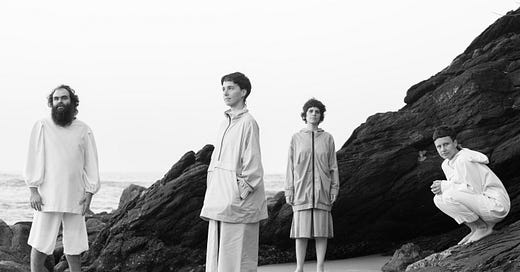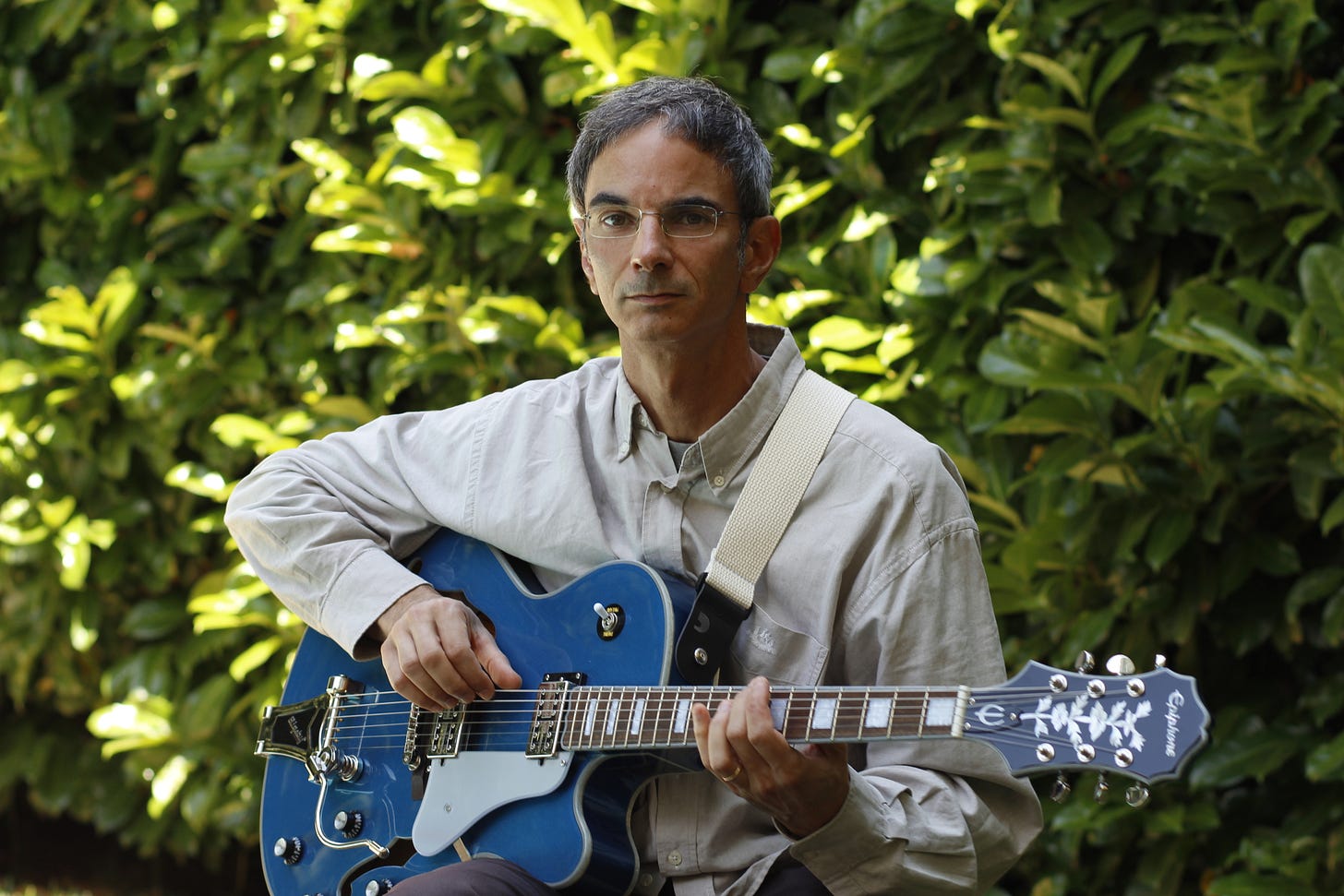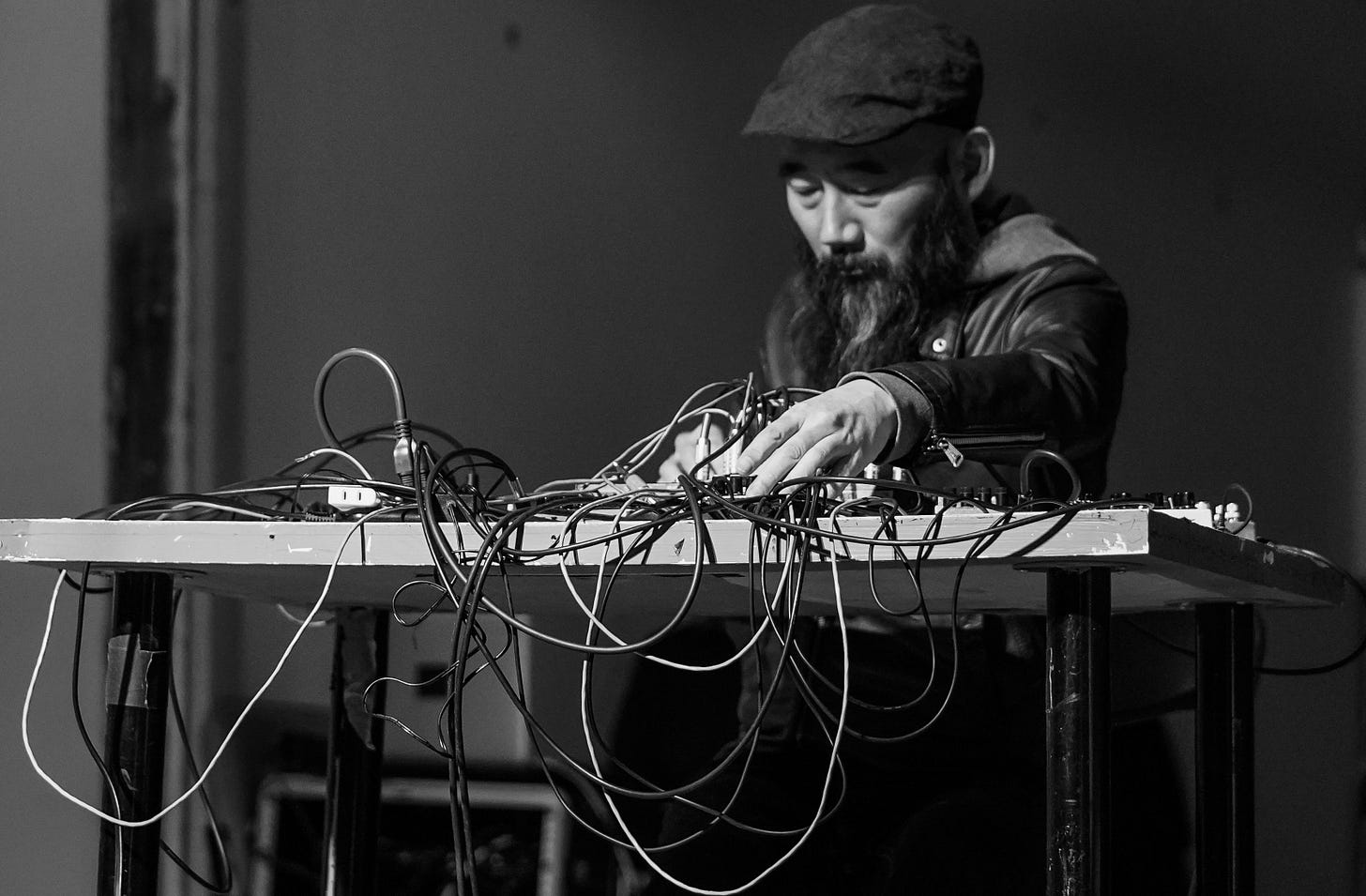Quartabê Marks it 10th Anniversary With its Best Record Yet
I feel lucky to live in the same city as the Brazilian musician Mariá Portugal, because I regularly get to see and hear her make music in all kinds of different contexts. A couple of weeks ago I heard her perform with the Erasão Percussion Trio alongside Burkhard Beins and Emilio Gordoa at Morphine Raum—the closing event in an extended recording engagement—in which she magically conjured tender, hypnotic vocal melodies within a texture-rich set of extended techniques and sustained, bowed tones. Berlin has lots of great improvisers, but I don’t know too many musicians so adept at locating pop-like splendor within the most abstract sounds—Portugal has a sui generis gift in this regard. I’ve been able to experience her performing this feat in all kinds of contexts, but few of her projects convey more joy and beauty than with Quartarbê, the São Paulo collective she’s been part of for ten years. She’s currently back in her native country celebrating the band’s anniversary with a tour. Until the quartet returns to Berlin, though, I’m very happy to have some new music released to mark the occasion.
At first glance Repescagem (Selo Risco) might seem like a minor extension of the music featured on Quartarbê’s 2018 album Lição #2: Dorival, on which they salute and transform the music of the great Dorival Caymmi, abstracting, stretching, and re-imagining classic samba in a modern, improvisation-heavy context. The performances I’ve seen of this material have been consistently extraordinary, operating like community rituals that bring listeners together. Quartarbê aren’t confined by any single tradition, and while the samba essence of the Caymmi material is always present, the band seems able to take the music wherever they feel like it. Which means, on second glance, Repescagem is a subtle masterpiece that achieves a new peak for the group. It was recorded in Brazil last August and the band’s members—Portugal, clarinetists Maria Beraldo and Joana Queiroz, and keyboardist Chicão, all of whom also sing—reveal an incredible confidence as they stretch the material in all kinds of directions.
The heart of the album is a three-part dissection and expansion of the Caymmi tune “Quem Vem Pra Beira Do Mar.” All four members play deconstructed lines on acoustic guitars, all recorded with devastatingly rich detail and depth. On the opening “Andei por andar, andei” glissing guitar chords punctuated by some plucked notes run up and own in a dizzying massage of warped tones, while the group sings four lines from the tune’s first verse together, slowly moving from abstraction into something more song-like. There’s a cool sashaying quality to their version of “Maricotinha,” with guest vocals by Na Ozzetti, opening with an elaborate wordless vocal arrangement before the bass clarinets of Beraldo and Queiroz dance around the chill groove, but as the performance unfolds it takes several thrilling digressions, with some delightfully psychedelic keyboard spasms from Chicão taking the tune into outer space at the end. They return to the acoustic guitar and the second half of that first verse on “A onda do mar leva,” where there’s still a hint of those warped chords, but this time out the group dives straight into the melody, with the joint vocals taking center stage. The group transforms the sentimental ballad “Não Tem Solução,” famously recorded by the great crooner Dick Farney, into an instrumental electro-jam built around Portugal’s four-on-the-floor kick and the unison clarinet patterns of Beraldo and Queiroz. My favorite track, which you can hear below, is the group’s version of “Eu cheguei lá,” which is immeasurably enhanced by the lead vocals of Mart'nália, the daughter of samba legend Martinho Da Vila. I’ve enjoyed some of her records, but her raspy performance here is a mind-blower, a deeply intimate performance of earthy beauty. As with everything on the record, the arrangement is superb—even when the tune adapts a somewhat generic reggae feel. A cool jazz vibe distinguishes their sensitive account of João Valentão ,” where lyric clarinet improvisations are the focal point. The album concludes with the third and final installment of “Quem vem pra beira do mar,” finally given its proper title, with additional lyrics and yet another tweak on the four-guitar arrangement. I can’t wait to hear how they manipulate and experiment with this material live, but for the moment I’m content with the new record.
Rafael Toral Has Returned to the Guitar, Fortified by Decades of Sonic Research
In 2004 Portuguese musician Rafael Toral launched his project Space Program, in which he dispatched guitar and devoted himself exclusively to a gesture-driven feedback system that became his primary focus until 2017. I’ll admit that I lost interest, even though I found his ideas fascinating. As he recently told Joshua Minsoo Kim in an interview earlier this year, “The Space Program is based around one single idea: trying to propose a way of understanding electronic music, which is not machine-driven but has a more human source in terms of approaching electronic music in an instrumental way.” Still, I had been unable to connect to this soundword, which sounded like a theremin with a more explicit, sharp-toned feedback quality. When Jim O’Rourke began advocating Toral’s work three decades ago, I dug in but I failed to fully appreciate his mastery of texture. As Bill Meyer astutely noted in an essay included in a reissue of Toral’s 1995 gem Wave Field, depending on the playback volume the music can seem gentle and aqueous or bruising and hard. There was a lot going on within his blocks of sound.
Still, even after hearing lots of folks whose taste I trust rave about Toral’s recent album Spectral Evolution (which pushed O’Rourke to revive his Moikai label in order to release it), I assumed the excitement was mostly due to because he picked up the guitar after a long absence. While that instrumental shift is welcome, the piece revealed facets of his music I never knew existed. It’s almost as if Toral has spent the last thirty-some years conducting research, practicing, and thinking so he could formulate his current work, which feels way more than the sum of that long history. Spectral Evolution, which was composed and arranged as a single, uninterrupted work, bursts with crystalline melody, dynamic counterpoint, and gorgeous harmonies. Yes, there’s plenty of guitar, but the almost orchestral arrangements were largely created with the same tools of the Space Program, which suddenly feels like a mini-symphony. The machines don’t sound like a synthesizer or a sample-based tool in Toral’s hands. There are all kinds of lines, fragments, and swells that leap out of the composed material, which can suggest a brass line or birdsong. The album art is a close-up photo of a passerine, and according to Toral that image implants the notion in the head of the listener, who interprets certain sounds as birdsong. As Toral said in the interview with Kim, “…it’s not in the music; it’s just how the brain associates the two when looking at the bird photo and listening to the music. If there was a car on the cover you wouldn’t think about birds as easily.”
Toral did something of an about-face for the new album, turning from pure improvisation and instead building the piece from some of the most iconic chord changes in all of jazz, including the ubiquitous Rhythm changes. Indeed, Spectral Evolution, which opens with a warm, twangy strummed guitar chord, conveys a deep warmth of familiarity, gliding along on patterns that form the backbone of so many classic pop songs, but Toral abstracts the form by slowing it down to a crawl, and sometimes so slow that the movement is almost unnoticeable. As the guitar serves up liquid arpeggios we hear whistling melodies and arcing, trombone-like legato swells. “Changes,” the second part of the piece, lays out those harmonic building blocks, but they’re surrounded by so much interplay, chatter, and dovetailing shapes that the whole structural underpinning seems to vanish. Of course, it’s decidedly present, offering the groundwork for Toral’s wild color palette and garrulous embroidery, but the obvious focal point is how he translates all of that sonic research into music of arresting detail and density. Below you can hear the “Intro” and most of “Changes,” which, like everything here, flows from one into the next.
I haven’t done any kind of analysis, but as the piece unfolds the pace of the changes seems to slow down radically, as if Toral has frozen time. Considering his attention to harmonic detail, that glacial tempo becomes a source of magic, letting us bask in the various layers and grain of the sound. There are clear throughlines from early works like Wave Field to what’s going on here, but Toral’s touch and virtuosity allows for a more explicit narrative arc than before, where there’s a deliberate blurring of instrumental sounds and environmental/natural ones. Indeed, the album carves out its own environment, simultaneously urban and remote. In the middle of the album on “First Long Space” we get a ravishing feature for his guitar, which emits a tonal warmth akin to Tom Verlaine, with Toral improvising over the changes of Billy Strayhorn’s “Take the ‘A’ Train” at a snail’s pace. It’s extravagantly beautiful, just one part of what’s arguably Toral’s unexpected masterpiece. He’ll play this music in Berlin this week in the Kuppelhalle of Silent Green on Thursday, June 20. Jessica Sligter opens.
Riding Currents of Sound with Toshimaru Nakamura and Kjell Bjørgeengen
It’s nice that we no longer marvel at the novelty or oddness of the no-input mixer that Toshimaru Nakamura developed into a legit sound practice, one that others have subsequently embraced. I’m not trying to minimize or discredit his innovation. I’ve been captivated by his music since I first heard it around the turn of the century because he not only forged a dynamic sonic world of his own elegantly simple hack, but he proved how malleable he was as an improvisers, perpetually maintaining his own distinct identity while adapting and responding to varied settings with just as much alacrity, resourcefulness, and openness as anyone playing a more conventional instrument. It’s been a long time since I really thought of him as anything other than an improviser, full stop. That said, it’s been a while since I’ve heard him live—back in 2019 as part of Magnus Granberg’s Skogen here in Berlin at an event organized by Splitter Orchestra—and I hadn’t heard much of his recent recorded output.
Nakamura is returning to Berlin this week, playing on two different programs at KM28. On Thursday, June 20 he’ll perform solo, sharing the evening with the duo of Norwegian video artist Kjell Bjørgeengen and guitarist Kazuhisa Uchihashi, while on the 21st he’ll play a duo with crys cole and in a trio with Bjørgeengen and sound artist Kaffe Matthews—with another set in-between by Lost Jockey, a trio with Lucio Capece, Quentin Tolimieiri, and Burkhard Beins. I checked into a couple of Nakamura’s recent releases and not only do they all find him gracefully fitting into and enhancing disparate contexts, but his command and vocabulary seem to increase manifold with each passing year. I am particularly knocked out by Idiomatic Expressionism (Ftarri), his 2021 album with long-time collaborator Tetuzi Akiyama, playing acoustic guitar. The dichotomy between Toshimaru’s squelchy electronic tones, sometimes whispery and hushed, at other times lacerating like a violent live wire, and Tetuzi’s warm splintered chords and jagged post-Dailey splatters is something else, two seemingly incongruous sound worlds colliding, melting together, and skulking over time, masterfully paced and placed. Check out the almost lyric opening track, below.
More recent and in a completely different—yet still improvised context—is
Kinjo no Tabibito (meenna), a trio session with veteran reedist Akira Sakata and drummer Raiga Hayashi. Those latter two set the tone, unleashing fiery free jazz with impeccable rising-and-falling swells. That wouldn’t seem like an ideal context for Toshimaru, but he has no problem finding his way, laying down caustic blankets of sound that seethe, spread, and wave, but rarely dominate the way the other instruments do. Rather, the electronics viscerally enhance the frontline action, simultaneously offering a platform while making sure that foundation experiences patches of violent instability. Still, Toshimaru goes get his licks in, as one can hear about five minutes into the recording below, where he unleashes a writhing spasm of snake-like feedback that jousts head on with Akira’s bright alto.
Bjørgeengen dwells within an even more austere sound world, but that’s because part of his practice is feeding signals from an oscillator into video sync signals, which translate into abstract patterns on a video screen, not as a direct representation of the waveforms but as “a direct identity between sound and image.” Bjørgeengen subsequently enlisted Dave Jones from the Experimental Television Center in New York to create an electronic device, called a “flood coil,” that would pick up aural debris from the video monitor to contribute sound to his performance. In the case of the forthcoming album A Thought for Two (True Blanking), a duo album made with the singular improviser Keith Rowe in New York back in 2010, that audio debris was used by the guitarist as part of his source materials. As you might surmise, the recording is quite barren, but the shifting array of electronic pops, hums, and upper register noises quietly offers a panoply of morphing rhythms and textures. The same label is releasing another album with AMM pianist John Tilbury joining the pair: Flicker, Scratch and Ivory, recorded live at Cafe Oto in 2018, is also released on July 3.
Last year Sofa Records and True Blanking issued Fear of the Object, a dazzling 4-CD box set chronicling a series of performances by Bjørgeengen and the American percussionist Chris Cogburn, whose sonic output is often as sparse as the video artist. The project documents four concerts played with a variety of collaborators in Madrid, Coyoacán, Oslo, and Mexico City in 2017. There’s something gratifying about submerging oneself in such a specific sound world in a concentrated period—I worked my way through the whole set in a single day last week and I never grew fatigued, although some of that credit belongs to the other players that participated: percussionist Ingar Zach, cellists Judith Hamann and Aimée Theriot-Ramos, and double bassist Juan García. The music in this set was designed to explore and compare the contrasting resonances of objects and electronics, further interceded by traditional instruments played in stripped-down fashion. This is music of exquisite fragility and care, and it’s impressive how integrated and fruitful Bjørgeengen video-derived contributions are. Below you can check out the opening piece from the Mexico City concert, with Hamann and García.
Recommended Shows in Berlin This Week
June 18: Etran de L'Aïr, 8:30 PM, Gretchen, Obentrautstr. 19-21, 10963 Berlin
June 19: Kommun (Lisa Ullén, piano, Finn Loxbo, guitar, Vilhelm Bromander, double bass, and Ryan Packard, drums), 8:30 PM, Sowieso, Weisestraße 24, 12049 Berlin
June 19: Apparat plays Timothy McCormack & Charlie Sdraulig; Tintin Patrone, 8:30 PM, KM28, Karl Marx Straße 28, 12043 Berlin
June 19: Enrico Malatesta, percussion; Luciano Maggiore, electronics, objects; Ruth-Maria Adam, violin, voice, 8:30 PM, Experimentik, TIK-Theater im Kino (Nord), Rigaer Straße, 77, 10247, Berlin
June 20: Betrand Denzler, saxophone, Derek Shirley, double bass, and Steve Heather, drums, 6 PM, Café Plume, Warthestraße 60, 12051 Berlin
June 20: Der lange Schatten (Michael Thieke, clarinet, Antonio Borghini, double bass, and Håvard Wiik, piano), 8:30 PM, Sowieso, Weisestraße 24, 12049 Berlin
June 20: Toshimaru Nakamura, solo no-input mixing board; Kjell Bjørgeengen, live video, and Kazuhisa Uchihashi, electric guitar, 8:30 PM, KM28, Karl Marx Straße 28, 12043 Berlin
June 20: Rafael Toral; Jessica Sligter, 8 PM, Kuppelhalle, Silent Green, Gerichtstraße 35, 13347 Berlin
June 21: Toshimaru Nakamura, solo no-input mixing board, and crys cole, objects, eletcronics; Lost Jockey (Lucio Capece, soprano saxophone, Quentin Tolimieri, piano, and Burkhard Beins, drums); Toshimaru Nakamura with Kjell Bjørgeengen, live video, and Kaffe Matthews, electronics), 8:30 PM, KM28, Karl Marx Straße 28, 12043 Berlin
June 22: Günter Baby Somer’s Brother & Sisterhood (Anna Kaluza, alto saxophone, Silke Eberhard, alto saxophone, Frank Gratkowski, alto saxophone, flute, Gebhard Ullmann, tenor saxophone, bass clarinet, Matthias Schubert, tenor saxophone, Raymond MacDonald, alto and soprano soprano saxophones, Anke Lucks, trombone, Marleen Dahms – trombone, Gerhard Gschlößl, trombone, Nikolaus Neuser, trumpet, Martin Klingeberg, trumpet, voice,Uli Gumpert, piano, Antonio Borghini, double bass, Günter Baby Sommer, drums); Gorilla Mask (Peter van Huffel, alto & baritone saxophones, electronics, Roland Fidezius, electric bass, effects, and Rudi Fischerlehner, drums, percussion), 4 PM, Jazz am Kaisersteg, Hasselwerderstr. 22a, 12439 Berlin-Niederschöneweide
June 22: Tobias Delius, solo reeds; Taiko Saito, vibraphone, Isabel Anders, piano, and Edward Perraud, drums; Delius, Saito, Anders, Perraud, 8 PM, Kuhlspot Social Club, Lehderstrasse 74-79, 13086 Berlin
June 24: Lisbeth Quartett (Charlotte Greve, saxophone, Manuel Schmiedel, piano, Marc Muellbauer, double bass, Moritz Baumgärtner, drums), 8 PM, Uferhallen, Uferstr.8, 13357 Berlin








Big fan of Mariá here.